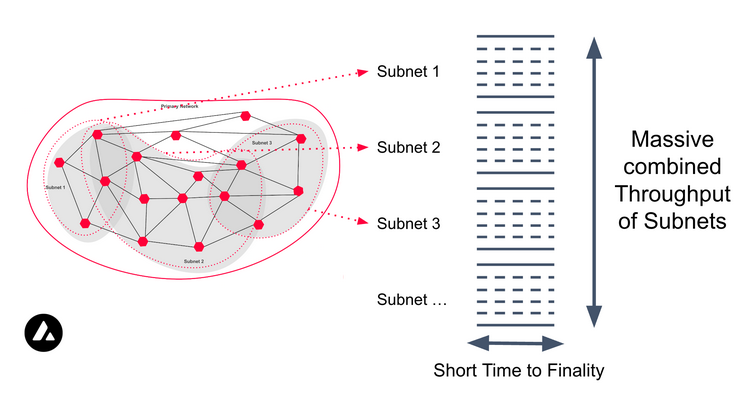Let's look at the generations of a blockchain world. When the first blockchain was launched, it was a single-chain network with a single asset. Bitcoin was one of the first blockchains. Then, Ethereum came out and opened new possibilities for multiple assets - it allowed not only having a native token but also NFTs and all kinds of real-world assets.
What’s next? Multi-Chain Networks
It allows multiple chains on a network with multiple assets. Avalanche is a third-generation chain that comes to solve the problems of scalability, customization, and independence.

Challenges with existing Blockchain and how Subnets are solving it
Scalability
If you want to build on chain you will absolutely face big problems with scalability. When too many people use a blockchain network and make too many transactions, the network gets very slow.
Avalanche Subnets scale horizontally and allow for the creation of multiple parallel chains, each with its own set of validators and resources. Creating additional Subnets allows the overall network to process more transactions simultaneously without becoming overloaded.
Independence
During bull markets, traditional blockchains become congested, leading to higher fees and inaccessibility. In single-chain networks, high usage in one area drives up fees for all users.
Avalanche Subnets solve this by operating as independent blockchains with separate fee markets. If one Subnet experiences high demand, its fee market adjusts accordingly, but this increase is isolated, leaving other Subnets and the main network unaffected.
Customizability
Subnets are also highly customizable. Avalanche has two main parts: a shared base layer and separate building blocks on top. The base layer is called the consensus layer. It is the foundation that the whole Avalanche network is built on. This layer makes sure everyone agrees on what data is added to the network. On top of this base layer, there are different "execution environments."
These are like separate rooms where developers can build their own applications using smart contracts and custom rules. The unique feature about Avalanche is that these execution environments are independent from each other and from the base consensus layer.
Developers have full control over their own execution environment and can customize and change the rules in their environment without affecting the entire Avalanche network or other developers' environments. They don't need to get approval from anyone else.

Compliance
Blockchains are designed to be immutable, making it nearly impossible to modify or delete data once recorded. This creates a conflict between the immutable nature of blockchains and the need to comply with data privacy laws that require data mutability.
Subnets allow for the creation of permissioned blockchain instances where data can be kept private and access can be strictly controlled. Developers can define custom access controls, permissioning, and governance models for their Subnets, ensuring that only authorized parties can participate in the network. This feature is particularly valuable for enterprises and organizations that require strict security and compliance measures.
How it works under the hood: Overview of Subnet Architecture
Avalanche is built on three interoperable blockchains: the Exchange Chain (X-Chain), the Platform Chain (P-Chain), and the Contract Chain (C-Chain).
Avalanche Subnets are independent blockchains that run in parallel with the primary Avalanche network. They are created and managed by the P-Chain, which keeps track of their configurations and validator sets. Each Subnet has its own virtual machine, consensus protocol, and set of validators. This allows for customization and optimization based on the specific requirements of the applications or use cases.

Imagine Avalanche Subnets like a system of interconnected neighborhoods in a larger city. Avalanche network is like a major metropolitan city. It has a central infrastructure, resources, and a governing body (the Avalanche protocol and its rules).
Subnets are like individual neighborhoods or communities within this city. Each Subnet is a self-contained area with its own set of rules, regulations, and resources (validators, virtual machines, consensus mechanisms, etc.). Just like neighborhoods can have their own community centers, parks, and local governance, Subnets can be customized to suit the specific needs of the projects or applications they host.

But these neighborhoods (Subnets) are not isolated islands. They are connected to the main city (Avalanche network) through roads, public transportation, and shared utilities. Similarly, Subnets can interoperate with the main Avalanche network and other Subnets through cross-chain communication protocols like Avalanche Warp Messaging (AWM).

This allows for the seamless transfer of assets, data, and messages between different Subnets and the main network. Just as neighborhoods can have different characteristics (residential, commercial, etc.), Subnets can be tailored for various use cases like DeFi, gaming, NFTs, CBDCs, and more.
Some Subnets may be open and permissionless (like public neighborhoods), while others may have stricter access controls. As the city grows and new neighborhoods are developed, more Subnets can be added to the Avalanche ecosystem to accommodate increasing demand and scalability needs.
This horizontal scaling allows for an urban expansion, where new neighborhoods are built to support a growing population without overcrowding the existing areas.
Getting Started with Avalanche
The best way to start building on Avalanche is by reading documentation , checking out Avalanche Academy and exploring Avalanche architecture and consensus mechanism in more details. You can build your first Subnet just by following this easy step by step guide here.
